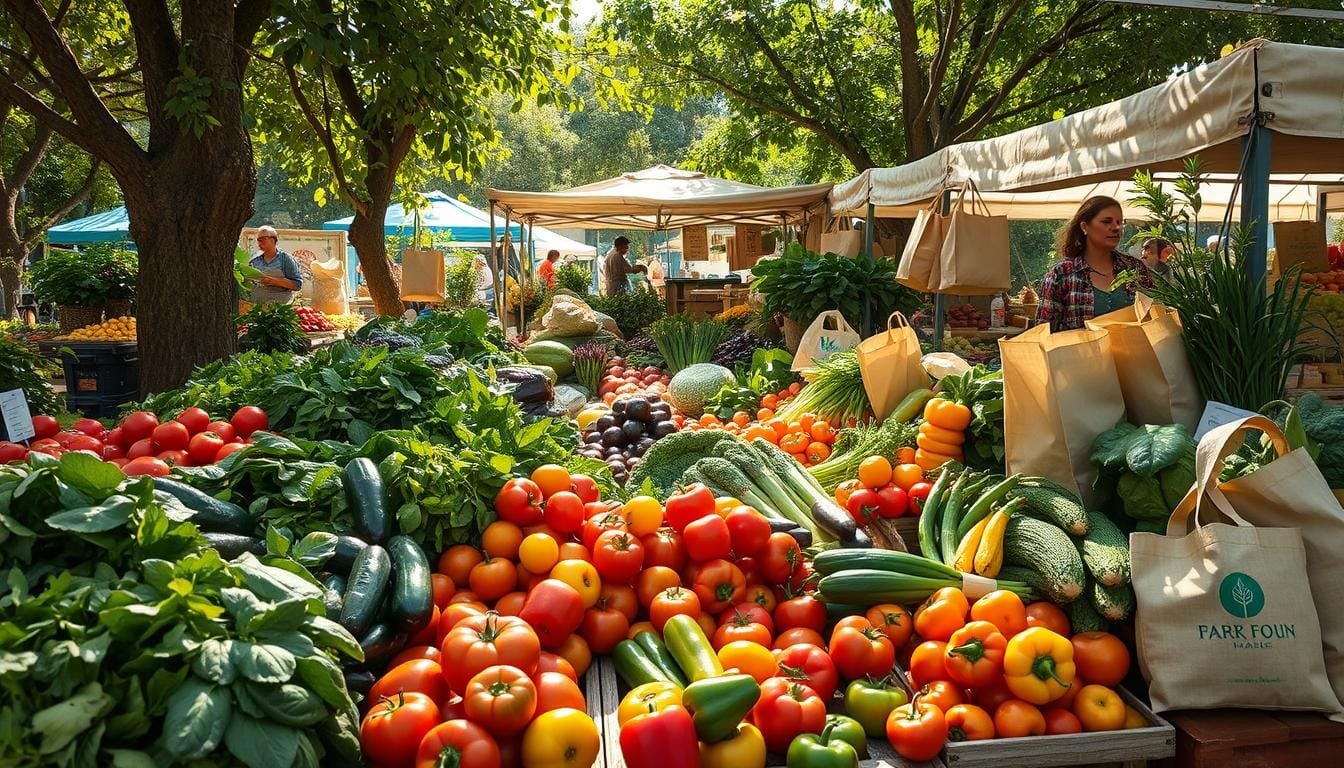Did you know that eating plant-based can lower your risk of heart disease by 19%? It also cuts down the risk of dying from any cause by 11% compared to those who eat less whole food. This shows how important a diet full of whole foods is for our health and how long we live.
In this guide, we’ll dive into the world of whole foods. We’ll look at their nutritional value and the benefits of eating whole foods. We’ll also give you a list of the best whole foods to add to your meals. By learning about natural, minimally processed foods, you can make better choices for your health and well-being.
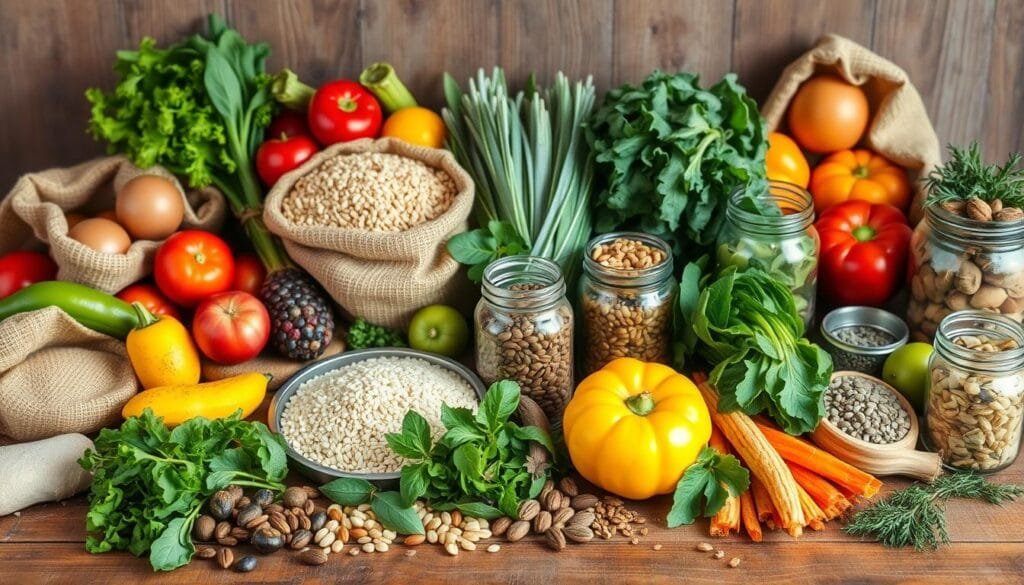
Key Takeaways
- Whole foods are minimally processed and close to their natural state, providing essential nutrients and health benefits.
- A diet rich in whole foods, such as fruits, vegetables, whole grains, and lean proteins, is associated with reduced risk of chronic diseases like heart disease, cancer, and type 2 diabetes.
- Incorporating a variety of whole foods into your meals can promote weight loss, support gut health, and boost overall wellness.
- Transitioning to a whole foods lifestyle requires planning, organization, and an understanding of food labels to make informed purchasing decisions.
- Sustainable and environmentally-friendly whole food choices can have a positive impact on the planet as well as your health.
Understanding Whole Foods and Their Impact on Health
Choosing between whole and processed foods is key to feeding our bodies right. Whole foods like fresh fruits, veggies, whole grains, and lean proteins are the heart of a healthy diet. They are less processed, keeping their natural vitamins, minerals, and fiber. These are often lost in processed foods.
Defining Whole vs. Processed Foods
Whole foods are those that are barely processed and don’t have artificial stuff. Processed foods, on the other hand, lose a lot of their nutrients. Foods like frozen veggies and whole wheat flour are whole, offering a cleaner eating option.
The Nutritional Value of Natural Foods
Whole foods are packed with vitamins, minerals, and antioxidants. For example, whole grains like brown rice and oats have more healthy fats and fiber than white bread or pasta. Fresh fruits and veggies are full of nutrients our bodies need.
Impact on Overall Wellness
Eating more whole foods can greatly improve our health. A diet full of natural foods can lower the risk of chronic diseases and boost our immune system. By choosing whole foods, we nourish our bodies, leading to long-term health and vitality.
“Eating a variety of whole, unprocessed foods is the foundation of a healthy, balanced diet.”
Benefits of Following a Whole Foods Diet
Choosing a plant-based diet and a whole food plant-based lifestyle brings many benefits. It helps us stay healthy and reduces the risk of chronic diseases. Eating whole, natural foods improves our overall well-being.
Research shows that eating lots of fruits, veggies, and whole grains is good for us. It can lower the risk of heart disease, some cancers, type 2 diabetes, and stroke. These foods are full of antioxidants that protect our cells and keep us healthy for a long time.
Whole grains are especially good for us. When grains are refined, they lose important fiber and nutrients. This makes them less healthy. Whole grains, on the other hand, have all the nutrients we need, working together to keep us healthy.
A whole foods diet also helps with weight management. Foods high in fiber keep us full longer, helping us stay at a healthy weight. Studies show people eating plant-based, whole foods diets can lose up to 25 pounds in a year.
Choosing a whole foods lifestyle is good for our bodies and the planet. It reduces greenhouse gas emissions, land use, and water use. This makes it great for our health and the environment.
Starting a whole foods diet might take some extra time at first. But the long-term benefits are worth it. By eating nutrient-dense, whole foods, we can live healthier and help the planet.
List of Whole Foods for Your Kitchen
Building a healthy kitchen starts with whole foods. These include fresh fruits, veggies, whole grains, and lean proteins. They are the base of a nutritious diet. By filling our kitchens with these ingredients, we nourish our bodies and enjoy real food’s flavors.
Fresh Fruits and Vegetables
It’s key to fill our carts with colorful produce. Leafy greens like kale and spinach are full of vitamins. Broccoli and cauliflower boost fiber and antioxidants.
Don’t miss out on berries and citrus fruits. They add natural sweetness and nutrients.
Whole Grains and Legumes
Whole grains like quinoa and brown rice are packed with nutrients. Legumes, including lentils and black beans, are great for protein and fiber. They make meals versatile and healthy.
Lean Proteins and Healthy Fats
We need lean proteins like antibiotic-free chicken and wild-caught fish. Healthy fats from avocados and olive oil are also vital. They support our health and well-being.
Stocking our kitchens with these foods starts a journey of healthy cooking. It nourishes our bodies with the nutrients they need. Let’s choose natural, wholesome options and enjoy the power of real food.
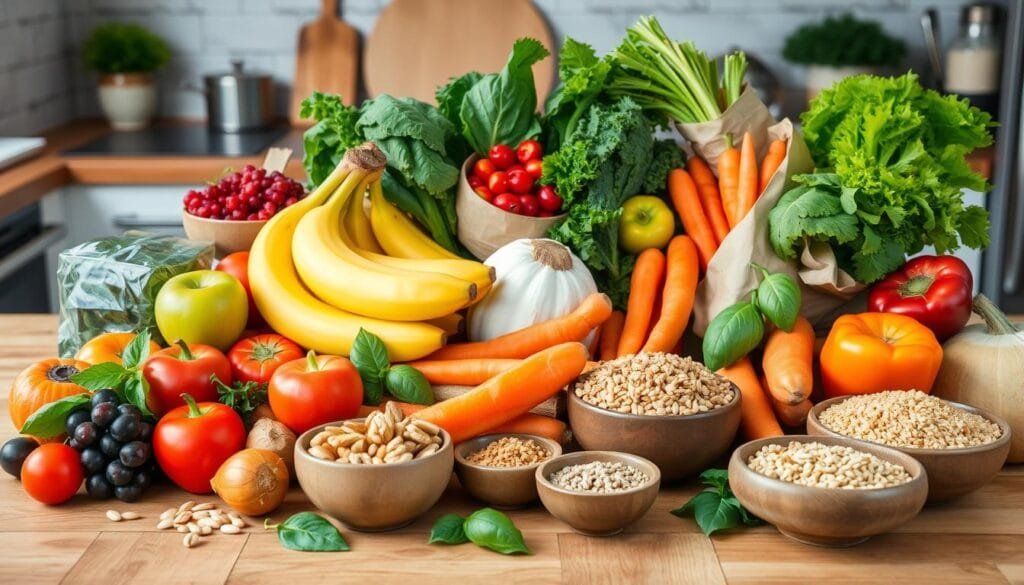
Essential Shopping Guide for Clean Eating
Embracing a clean eating lifestyle can change how you shop at the grocery store. Focus on whole, minimally processed foods to nourish your body. Here are some key tips for a successful clean eating shopping trip.
Start by shopping the store’s perimeter. This area has the freshest produce, lean proteins, and healthy dairy. Check out the natural foods aisle for grains, legumes, and other nutrient-rich items. Always read labels to avoid foods with long lists of unknown ingredients, artificial additives, and too much sugar.
Choose organic fruits and veggies to avoid harmful pesticides. Frozen produce is also a good choice, as it’s nutritious and convenient. For proteins, look for sustainably-sourced seafood, pasture-raised eggs, and hormone-free meats.
| Whole Food Category | Examples |
|---|---|
| Vegetables | Broccoli, spinach, bell peppers, sweet potatoes, zucchini, asparagus, and more |
| Fruits | Apples, bananas, berries, citrus fruits, melons, and more |
| Whole Grains | Brown rice, quinoa, oats, whole wheat bread, and more |
| Lean Proteins | Chicken, turkey, fish, eggs, legumes, and nuts |
| Healthy Fats | Avocado, olive oil, nuts, and seeds |
By stocking up on these clean eating essentials, you’ll nourish your body with the best foods. Happy, mindful shopping!
Transitioning to a Whole Foods Lifestyle
Starting a whole foods lifestyle is a big change that can really improve our health. By choosing whole foods over processed ones, we get lots of nutritional benefits. This helps our bodies work better and feel great.
Meal Planning Strategies
Good meal planning is key to a whole foods lifestyle. Look for foods like fresh fruits, veggies, whole grains, lean proteins, and healthy fats. Make a meal plan for the week that uses these foods. This way, you’ll get all the vitamins and nutrients your body needs.
Kitchen Organization Tips
To make cooking with whole foods easier, organize your kitchen well. Set aside space for foods like whole grain flours, nuts, seeds, and dried beans. Get simple tools like a good blender or spiralizer. A well-organized kitchen makes it easier to cook with whole foods every day.
Reading Food Labels
Learning to read food labels is important when you start eating whole foods. Check for added sugars, preservatives, and artificial stuff to avoid. Choose products with simple, whole food ingredients. This helps you make smart choices and keep your kitchen full of healthy, sustainable products.
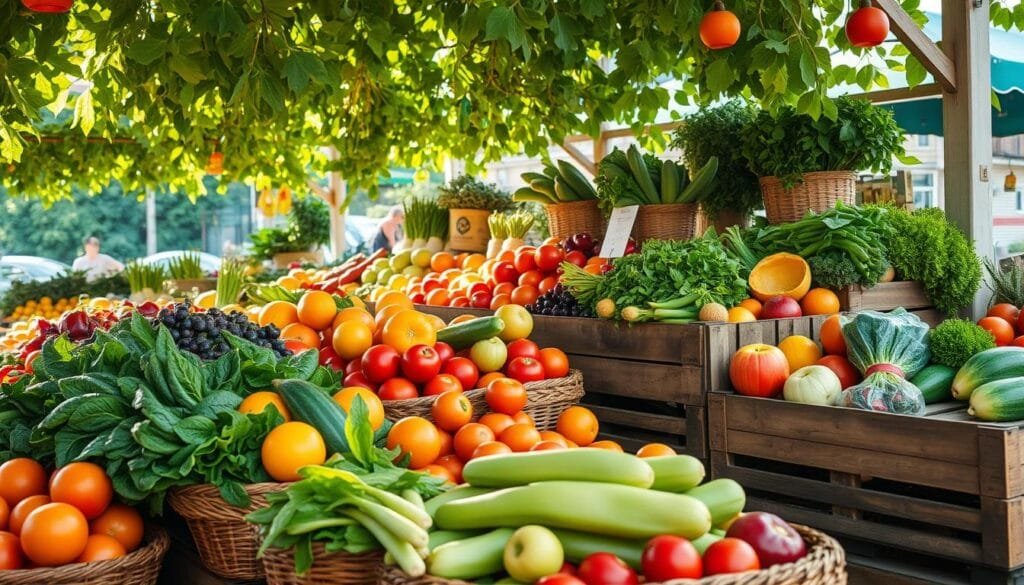
“A whole foods diet is a powerful way to support our holistic health and well-being. By embracing the natural goodness of whole, minimally processed foods, we can nourish our bodies, reduce our environmental impact, and unlock a world of vibrant, lasting health.”
Sustainable Food Choices and Environmental Impact
We can all make a difference by choosing sustainable food. Opting for whole, organic produce and eating less meat helps our planet. This choice reduces our carbon footprint and supports a greener food system.
Choosing sustainable products and organic produce benefits our health and the environment. It supports farming that saves resources and cuts down on harmful emissions. For example, buying local fruits and veggies means less shipping, which is better for the planet.
| Food Category | Greenhouse Gas Emissions |
|---|---|
| Red Meat | Higher |
| Dairy | Higher |
| Farmed Shrimp | Higher |
| Plant-based Foods | Lower |
We can also cut down on food waste by storing food right and using every part of fruits and veggies. Sadly, almost 1 billion tons of food is wasted each year. This waste is a big contributor to greenhouse gas emissions.
“Shifting towards plant-rich diets and reducing food waste can significantly lower greenhouse gas emissions from the food sector.”
Whole Foods is dedicated to sustainable practices. We help organic farmers with loans and offer many organic and Non-GMO products. We also use only sustainable palm oil in our products.
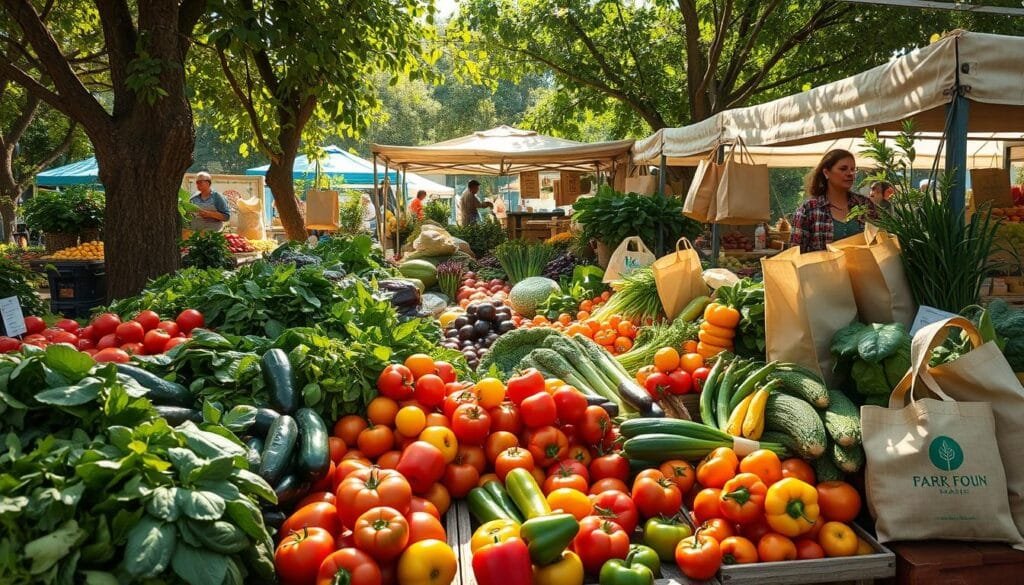
Whole Foods is also working hard to be more eco-friendly. We use wind energy to cut down on pollution, have solar panels in some stores, and provide electric vehicle charging stations. We’re even planning to switch our truck fleet to biodiesel to reduce emissions further.
By choosing sustainable food and supporting companies like Whole Foods, we can help create a better future. Together, we can make a big difference for our planet.
Whole Foods for Weight Management
Eating whole, nutrient-dense foods can help you manage your weight. These foods are full of vitamins, minerals, and fiber. They make you feel full and satisfied.
Portion Control Guidelines
Learning to control your portions is crucial for a healthy weight. Use smaller plates to gauge your serving sizes. Also, measure grains, proteins, and fats to avoid overeating.
Nutrient-Dense Options
Choose healthy food options rich in nutritious ingredients. These foods will nourish your body. Some of the best include:
- Leafy greens like spinach and kale
- Berries, such as blueberries and raspberries
- Lean proteins like grilled chicken or salmon
- Wholesome complex carbohydrates like quinoa and oats
- Healthy fats from avocado, nuts, and seeds
By making these nutritious ingredients the base of your meals, you’ll be on the path to a healthy weight.
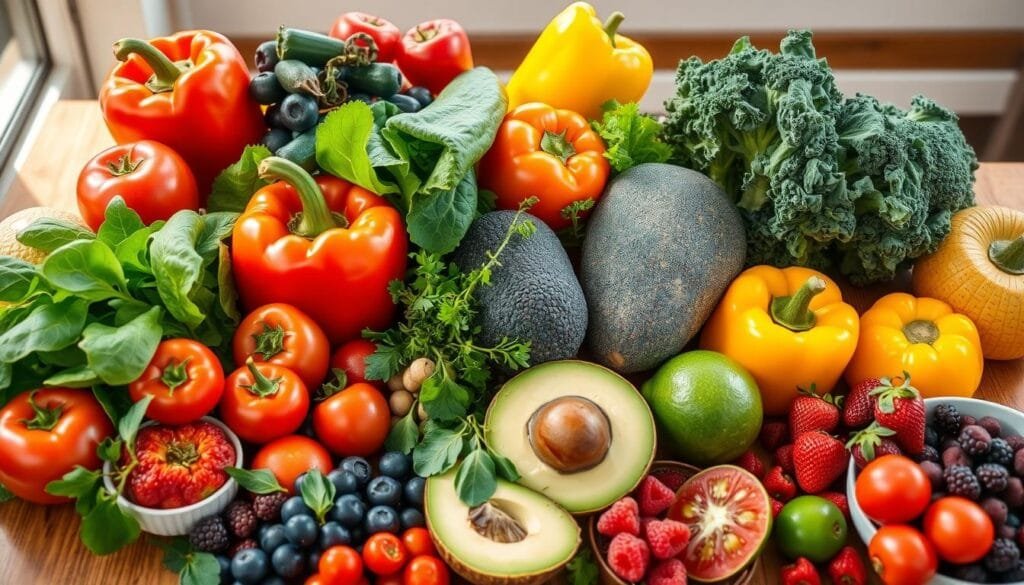
“Incorporating a variety of whole, nutrient-dense foods is the key to sustainable weight management. Focus on portion control and choose options that will nourish your body.”
Common Challenges and Solutions
Starting a whole foods, plant-based diet can be tough. But, with smart strategies, we can beat these challenges. One big issue is the cost of whole foods versus processed ones. To solve this, we can buy seasonal produce, buy in bulk, and plan meals ahead to cut down on waste.
Another problem is the extra time needed for whole food meals. To save time, we can spend a few hours on weekends cooking and prepping meals for the week. This way, we have healthy, homemade food ready, making it easier to avoid quick but unhealthy choices.
Dealing with social situations and sticking to a plant-based diet can be hard too. To get support from friends and family, we can teach them about the plant-based diet and whole food plant-based lifestyle. Being flexible and allowing ourselves treats now and then helps us stay balanced and not feel deprived.
FAQ
What is the definition of a whole food?
A whole food is very close to its natural form. It has no added sugars, starches, or artificial flavorings. Unlike processed foods, whole foods are not made in factories.
How do whole foods differ from processed foods in terms of nutritional value?
Whole foods keep their nutrients and fiber, unlike processed foods. They are made with minimal processing and no artificial additives. This makes them a better choice for getting essential vitamins and minerals.
What are the health benefits of following a whole foods diet?
Eating whole foods can help prevent chronic diseases. It can lower the risk of heart disease, cancer, and diabetes. It may also help with weight loss and improve digestion.
What are some examples of whole foods?
Fresh fruits and veggies like dark greens and berries are whole foods. Whole grains and legumes include quinoa and black beans. Lean proteins are found in meat, fish, and eggs. Healthy fats are in avocados and nuts. Greek yogurt and cottage cheese are also whole foods.
How can I shop for whole foods effectively?
Shop the perimeter of the store for fresh foods. Look for natural foods in the natural aisle. Always read labels to avoid bad ingredients. Choose organic produce to avoid pesticides. Pick fresh or frozen fruits and veggies without added sugars or salt.
What are some tips for transitioning to a whole foods lifestyle?
Start by replacing processed foods with whole foods. Plan your meals to include a variety of foods. Organize your kitchen for easy food prep. Learn to read labels to avoid bad ingredients.
How can choosing whole foods benefit the environment?
Whole foods are better for the planet. Choose local, seasonal produce to cut down on emissions. Consider plant-based proteins for a smaller environmental impact. Reduce waste by storing foods properly and using all parts of fruits and veggies.
How can whole foods aid in weight management?
Whole foods are full of nutrients and fiber, helping you feel full. Use smaller plates and measure your food. Choose foods like leafy greens and lean proteins for a balanced diet.
What are some common challenges in adopting a whole foods diet?
Challenges include higher costs and more prep time. Buy in bulk and plan meals to save money and time. Prepare food for the week to save time. Educate others about whole foods to get support. Be flexible and allow for treats to keep eating balanced.
